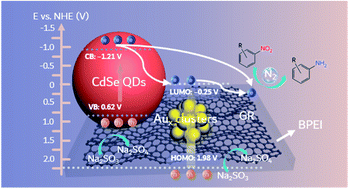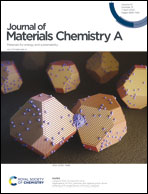Stabilizing atomically precise metal nanoclusters as simultaneous charge relay mediators and photosensitizers†
Abstract
Atomically precise metal nanoclusters (NCs) have been deemed to be emerging photosensitizers but suffer from a rapid charge recombination rate and poor photostability, which ruins the advantageous photosensitization efficacy of metal NCs and retards the construction of metal NC-based photosystems. Herein, we conceptually demonstrate the design of a transition metal chalcogenide quantum dot (TMCs QD)–metal NC–graphene (GR) ternary heterostructured photosystem via elaborate interface modulation, wherein atomically precise metal NCs are intercalated at the interface of TMC QDs and GR. The branched polyethylenimine (BPEI) molecule grafted on the GR framework functions as an efficient self-assembly-directing mediator, and simultaneously, stabilizes metal NCs to retain the generic photosensitization effect. The cooperative photosensitization effect of metal NCs and TMC QDs, interim charge relay mediator role of metal NCs, and electron-withdrawing capability of GR synergistically contribute to the cascade electron transport pathway for markedly boosting charge separation, resulting in considerably enhanced photoactivity towards selective organic transformation under visible light irradiation.



 Please wait while we load your content...
Please wait while we load your content...